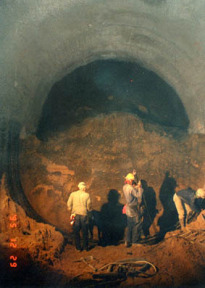Pan American Silver Shaftlining | Travases Manabi Hydro Project | Wine Caves | Limestone Mine | DC Metro Tunnels | Skokie South Leg Tunnel | Raw Water Intake Tunnel | Consorcio Linea II Tunnel Lining | Mumbai Storm Water System | Ecuador San Francisco Tunnel

Projects > Washington DC Metro Tunnels
Construction of the Metro mass transit line by WMATA (Washington Metropolitan Area Transit Authority, the owner and operator of all mass transit facilities in the U.S. capitol) started in 1970. Since then, new sections have been added in an ongoing program until 1987 when the last section of the current 89.5 mile (143.2km) operative network was under construction. In 1991, the final 13.5 mile (21.7km) segment of the project was begun, with final completion and opening to the public anticipated in 2001.
A potential trouble area for the WMATA project was the tunneling under the Rock Creek cemetery. Settlement under this old historical burial ground was a major concern. Settlement damage of any kind could not be tolerated and there could be absolutely no surface access to the tunnel alignment. Given these strict limitations, WMATA specified NATM methods for the two 2,400 foot (732m) long x 330 ft2 (31m2) running tunnels.
As part of the NATM operation, the Kiewit/Kenny joint venture contracted for the project used the wet shotcreting method, the first wet shotcreting application used on the system. Using shotcreting equipment, additives, and technical support supplied by Shotcrete Technologies of Idaho Springs, Colorado, the wet mix shotcrete was mixed at a batching plant on the surface and pumped a maximum distance of 1,600 feet (488m) to the face. Lattice girders, wire mesh and 7 inches (175mm) of wet mix shotcrete provide the initial NATM lining and support. The tunnels will stand some five months in their primary lined state before progressive installation of a waterproof membrane and the final 12 inch (305mm) thickness of unreinforced in-situ concrete lining.
Once again, Shotcrete Technologies' products and extensive NATM experience were combined to provide an effective solution for the WMATA project.



